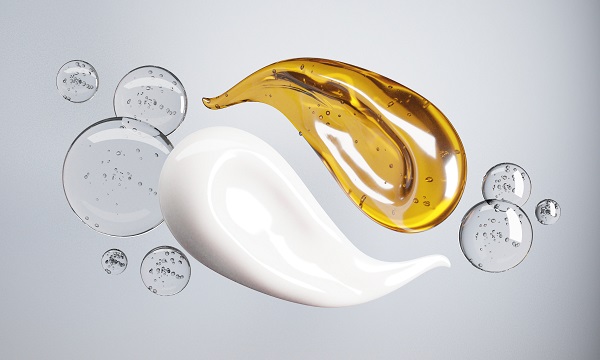ChatGPT said: What happens when emulsifiers are not used of a recipe
Emulsifiers: Key Ingredients for Attaining Flawlessly Combined Formulas
Emulsifiers play a vital duty in producing secure mixes of immiscible liquids, such as oil and water. Their unique buildings permit them to reduce surface area tension, which is essential for uniformity in different formulas. Understanding the distinctions in between artificial and natural emulsifiers can influence product top quality considerably. As sectors increasingly look for to improve appearance and service life, the option procedure for the right emulsifier ends up being extremely important. What factors should be considered in this critical option?
Comprehending Emulsifiers: What They Are and Just how They Work
Emulsifiers might seem like an easy enhancement to formulations, they play a crucial duty in stabilizing mixtures of ingredients that usually do not mix well, such as oil and water. These compounds operate by reducing surface tension at the user interface in between immiscible liquids, enabling them to mix even more uniformly. Emulsifiers consist of both hydrophilic (water-attracting) and lipophilic (oil-attracting) buildings, which enable them to anchor themselves at the border of both stages. By doing so, they develop a protective obstacle that avoids the beads of one liquid from coalescing right into bigger masses, consequently preserving a secure solution. The efficiency of an emulsifier depends on its molecular framework, which influences its capacity to stabilize blends. In various applications, from food items to cosmetics, emulsifiers guarantee a consistent structure and appearance, enhancing both performance and customer allure. Their significance can not be overemphasized in achieving well-blended formulas.
Sorts of Emulsifiers: Artificial vs. natural
Emulsifiers can be extensively categorized right into two types: synthetic and natural, each offering distinct benefits and applications. All-natural emulsifiers, originated from plant or animal resources, include lecithin, gum tissue, and casein arabic (emulsifiers). These emulsifiers are frequently preferred in organic and clean-label items as a result of their very little processing and biocompatibility. Their gentle nature makes them ideal for delicate solutions, particularly in food and cosmetics

On the various other hand, synthetic emulsifiers such as mono- and diglycerides, and polysorbates are manufactured with chemical processes. They are frequently used in industrial applications as a result of their security and performance in developing emulsions. Synthetic emulsifiers typically display superior efficiency in extreme problems, such as high temperatures or varying pH levels. The selection in between synthetic and all-natural emulsifiers mostly relies on the certain formula demands, regulative factors to consider, and customer choices, influencing their effective application in numerous markets.
Features of Emulsifiers in Food and Aesthetic Formulations
The role of emulsifiers extends beyond plain stablizing; they are essential in attaining the preferred shelf, texture, and look life of food and cosmetic items. In food formulations, emulsifiers assist mix oil and water, creating smooth and consistent textures crucial for sauces, dressings, and dairy items. They decrease surface area tension, improving the security of solutions, which stops splitting up and prolongs quality.
In cosmetics, emulsifiers ensure that components, such as oils visit this page and water, mix flawlessly, boosting and offering a pleasant feeling application. emulsifiers. They contribute to the product's viscosity and spreadability, vital for lotions, creams, and lotions. In addition, emulsifiers can encapsulate active components, enhancing their distribution and efficiency in formulations. By managing structure and improving sensory qualities, emulsifiers play a crucial role in conference consumer assumptions in both food and cosmetic industries, ensuring products are not just enticing however likewise functionally effective
Selecting the Right Emulsifier for Your Item

Additionally, the target application-- whether for food, cosmetics, or pharmaceuticals-- will certainly affect the option. Food-grade emulsifiers ought to conform with safety and security laws, while aesthetic emulsifiers may need skin compatibility. Evaluating variables such as HLB (Hydrophilic-Lipophilic Balance) assists in predicting emulsifier actions in certain solutions. Inevitably, a comprehensive analysis of both functional requirements and regulative considerations is vital to select the most reliable emulsifier, ensuring the end product fulfills the wanted top quality and stability discover this standards.
:max_bytes(150000):strip_icc()/eating-well-emulsifier-dressings-3021330094034a48961553c1a8aea356.jpg)
Tips for Effective Emulsion Development and Security
Achieving successful emulsion formation and security requires cautious focus to numerous critical variables. The selection of emulsifier plays a critical function; it must be suitable with the oil and water phases to ensure reliable stablizing. Second, the proportion of oil to water must be well balanced, view website as an incorrect proportion can bring about instability. Third, the mixing procedure must be managed; high shear blending can help achieve smaller droplet dimensions, improving security.
Temperature additionally influences emulsion security; maintaining suitable temperatures throughout formulation stops early splitting up. Furthermore, including stabilizers such as thickeners can further enhance viscosity, reducing the probability of phase separation. Finally, performing complete security tests after formula will assist identify prospective problems, allowing for modifications prior to last manufacturing. By adhering to these standards, formulators can attain dependable and regular emulsions that keep their desired buildings gradually.
Regularly Asked Inquiries
Can Emulsifiers Be Utilized in Vegan Formulations?
Yes, emulsifiers can be used in vegan solutions. Several plant-based emulsifiers, such as lecithin from soy or sunflower, provide effective blending without animal-derived active ingredients, making them appropriate for a range of vegan items.
What Prevail Irritants in Emulsifiers?
Usual allergens in emulsifiers consist of soy, dairy, and eggs, as specific emulsifiers are originated from these sources. In addition, some individuals may react to additives or chemicals used alongside emulsifiers in various formulations.

How Do Emulsifiers Effect Life Span of Products?
Emulsifiers enhance product stability by avoiding separation of components, thereby expanding life span. They alleviate spoilage triggered by microbial growth and oxidation, causing extended quality and boosted top quality in numerous food and aesthetic formulas.
Exist Any Health Problems Related To Emulsifiers?
Research shows potential wellness problems related to emulsifiers, consisting of gut microbiome changes and swelling. While regulative bodies typically consider them secure, continuous research studies continue to explore lasting results on health and wellness and general well-being.
Can Emulsifiers Improve Taste or Aroma in Formulations?
Emulsifiers can improve taste and scent in solutions by boosting component dispersion and stability. This results in an extra consistent item, enabling flavors to meld properly, inevitably bring about a much more enjoyable sensory experience for consumers.
Emulsifiers might appear like a straightforward enhancement to solutions, they play a crucial duty in stabilizing combinations of active ingredients that commonly do not mix well, such as oil and water. In food formulations, emulsifiers assist blend oil and water, creating uniform and smooth textures necessary for sauces, dressings, and milk products. Food-grade emulsifiers must comply with security guidelines, while cosmetic emulsifiers may require skin compatibility. Typical allergens in emulsifiers include soy, dairy, and eggs, as specific emulsifiers are acquired from these sources. Emulsifiers can enhance taste and scent in formulations by boosting ingredient dispersion and stability.